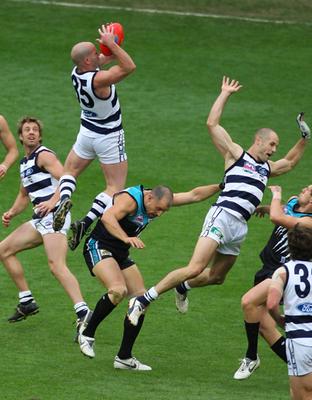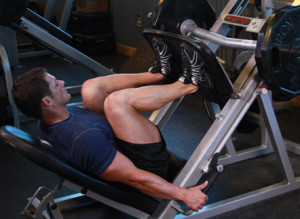The top 6 reasons why bodybuilding style training is no good for footy
1. Footy is about movement, not muscles – bodybuilding focuses on muscles, not movement.
There is a huge difference between looking good, and actually performing well in a game of footy. It is important to remember that bodybuilding techniques are performed with the end goal in mind purely being to look good in the mirror or on stage, with no functional component required in this past time. By that, I mean that the full extent of what someone training purely for bodybuilding is required to do is to stand on stage and selectively spasm a muscle. In football, physical tasks include accelerating, decelerating, changing directions, jumping off 1 leg or 2 legs, tackling and bumping (as well as absorbing these physical assaults), kicking, marking – and performing these tasks repeatedly over a 2 hour time frame. Fair to say that the physical requirements to play footy are a little more diverse and demanding to those required to stand in front of a mirror. This is an important first consideration in order to understand the faults of bodybuilding training techniques, when performance in footy is the goal, rather than your aesthetics with no function.
2. Sitting on machines will contribute nothing to your ability in tasks on gameday
By machines, I mean the pin-loaded or plate-loaded machines here, which operate on a fixed axis, meaning that all you need to do is pull or push or press and the machine follows a fixed path. Cable pulley systems do not count as machines in this definition as you still have complete freedom of movement, and are required to control the movement yourself, and are used extensively in Functional Strength Training for Australian Rules Football.
Bodybuilding techniques are focused purely on muscle building, via any means – this usually includes a large amount of this ‘Frankenstein’ style training, where you lock the body into a specific axis of movement, and then are required to do no more than push or pull or whatever, with no other requirement (no control, balance, coordination, core activation, etc.)
Such training requires very minimal work from your nervous system at all – and this is a BIG negative, because it is your nervous system that is responsible for EVERY SINGLE MOVEMENT AND TASK you perform on game day. Your nervous system controls everything – especially the movement and the quality of movement of your muscles. In reality, improvements in things like strength and power and speed aren’t really about improvements in your muscles, but rather are actually improvements in your nervous system, which controls these muscles. To effectively prepare for the challenges of gameday, your nervous system must be challenged and developed in order to improve, and sitting on machines will only serve to sedate the nervous system because with the machine providing all the support and stability for you, the nervous system has nothing to do. As a result, any strength you feel like you have developed on these machines (by gradually lifting more weight) will have zero transfer to gameday when your nervous system is required to work.
3. Prime Movers muscles will become way to strong in comparison to stabilisers – resulting in more injury
Your prime movers are the larger muscles on the outside (pecs, biceps, shoulders, quads, lats, hamstrings, etc) responsible for movements. These are the ones that you will see bulging in the mirror, and it is the development of these muscles that bodybuilding is fixated on. Stabilisers, or inner-unit muscles are unseen workers underneath these prime movers. These are the smaller muscles responsible for providing stability in and around joints all throughout your body, allowing the prime movers to do their work. Bodybuilding techniques have forgotten all about these, and most bodybuilders probably don’t even realise they exist – and why would they, you don’t get points awarded for how well your shoulder joint stabilises when you flex, which is just as well, because most bodybuilders wouldn’t be able to stabilise properly.
Tying in with the last point on machines, when performing these machine exercises, only your prime movers do any work, because with the machine itself performing the stability for you by locking you in position, your stabiliser muscles associated with the prime movers in the exercise, aren’t doing anything. As a result, your prime movers build up size and strength, but there is no proportional build up in the strength of your stabilisers. As a result of this imbalance, not only is injury FAR more likely to result on game day as a result of having a deltoid and pectoral combination that is far to strong for the associated stabilsers around the shoulder complex, but movement ability will also be greatly diminished, as there will not be the adequate stability ‘platform’ (stabilisers) required to ‘launch’ effective movement from (prime movers).
4. Isolating or training the body in parts will have zero transfer on gameday.
Every single movement task in a game of footy requires the integration of many muscles and muscle groups working together at any one time. There is not 1 that will require only muscle group working at a time. Literally every possible movement I can think of in a game of footy will require the whole body contributing in some capacity. As a result, breaking the body down into ‘shoulders day’ and ‘chest and tri’s day’ and the very occasional ‘legs day’ will have no transfer to game day – and like just about every other bodybuilding method will actually serve to decrease your output on gameday.
It is also important to realise that the brain (controller of the nervous system – which in turn controls ALL movement remember) only recognises movement, not individual muscles. This is very important to understand. Repeat; the brain only recognises movement, not muscles. As a result, just because you isolate a muscle or muscle group and blast the hell out of it, does not mean that this muscle will then be stronger in a movement where it is required to perform with the rest of the body on game day. For example, doing heavy seated chest presses over and over will not mean that you have a stronger push on game day to push off an opponent – when you need to also integrate you chest with your legs and core in a standing position – it will only mean that you are able to push seated chest presses on a pin loaded machine heavier, as this is all you have trained your nervous system to do. Why? You know the answer, because the brain recognises….ok ok ill move on.
5. Blasting the hell out of certain muscles is no good when you have games to prepare for, or you need to perform
This ties in nicely with the last point. The bodybuilding formula is to focus on a different body part or portion each session and blast the hell out of it. The very idea of training the whole body together – just as it is required in footy – is completely foreign to bodybuilding principles – and this is fair enough, because it suits the goals of bodybuilding. Bodybuilding is purely focused on muscle size, and therefore focusing on a different part everyday allows for recovery of that body part while focusing on a different part the next day, in order to continue to stimulate size. This is irrelevant in footy, where performance is what counts, not looks, and where isolating the body into parts is a very inefficient use of time, when you have club training and game day to fit in.
But there is the additional point of fatigue. ‘Destroying’ your chest, or biceps or shoulders isn’t the aim when preparing for football, because such fatigue levels will only diminish your performance. Of course fatigue after sessions is expected, but not on the ridiculous levels of muscular fatigue that are associated with isolating a muscle group and absolutely obliterating it for 90 minutes – largely with isolation and machine training. There is nothing to be gained here when footy is your goal.
6. Generalised Motor Program Compatibility – Absolutely non existent

Jumps are regularly performed in games of footy – off 1 leg or 2, and certainly standing. Therefore set a good baseline of functional strength with exercises that require you to perform similar movements, in a standing position, off both 1 leg or 2, that will require you to train your body through a very similar movement patters, such as squats and step ups

I think this guy is asleep here….he may as well be, you could literally to this with your eyes closed – unlike a jump or a contest involving a powerful leg and hip movement in a game of footy
This point basically means that for an exercise to be functional for football, it must train very similar movement patterns to those that are performed on match day. This would hopefully seem obvious by this point, but please read on, it may not be as obvious as it sounds. For example, a squat would be a similar motor program to a jump off 2 feet, a step up would be s similar motor program to a jump of 1 foot, as these require not only similar movements and in similar positions, but also, similar relative timing of the muscles involved. Or in other words, the muscles involved in the movement are contributing at the same relative time (to each other) as they are in the associated movements in a match situation. However do not be tricked into thinking that a leg press would have a similar carryover to the double leg jump as a squat does, because a leg press and a vertical jump are not similar generalised motor programs and a leg press and a vertical jump do not have similar relative timing in movements. A leg press is useless for movements in football. For starters, a leg press virtually isolates your knee joint; there is no hip involvement at all because it is locked in place. Ok great, so we have already eliminated the primary joint responsible for jumping (the hip) from the movement, but then to top it off, we are also sitting down, or lying on a 45- degree angle. These are positions and movements that you will never find your self in and never be required to perform in a game of footy, and therefore, there is no carryover via a generalised motor program as there is with a squat.
These are only 6 very brief points in which I tried to be as concise as possible, but we are only just scratching the surface here. But I cant be any stronger on the point that if you are genuinely looking to improve you performance with both effective as well as safe (injury reduction on game day) strength training, you must give standard bodybuilding methods a wide berth. Bodybuilding style training protocols are fine if the mirror and posing on stage are your end goals. But when preparing for a complex and demanding task with so many physical requirements like footy, your program should be a lot more focused towards this task.
Strength Coach

